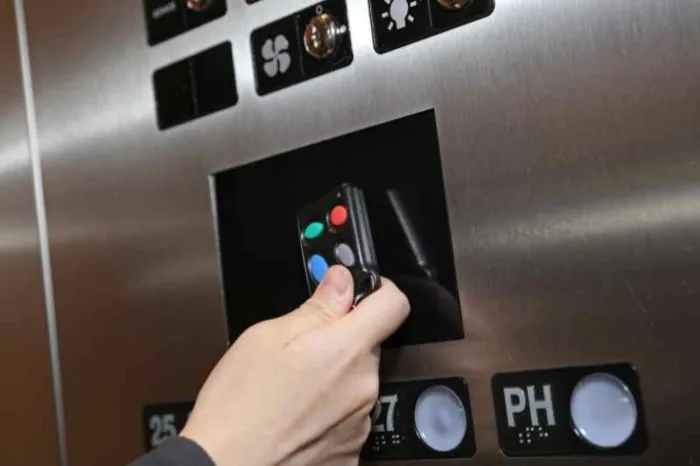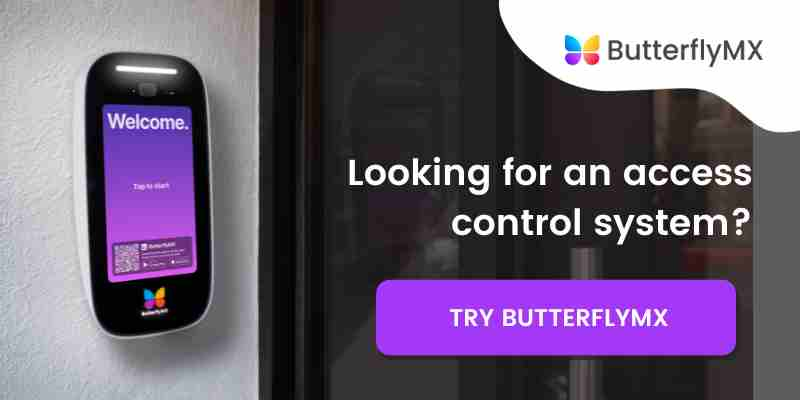Takeaways
- Access control readers are devices that scan credentials to determine if a user is authorized to gain access to your property.
- The most common types of access control readers are keycard readers, keypads, biometric fingerprint readers, fob readers, vehicle tag readers, Bluetooth readers, and two-factor authentication.
- Cloud-based access control is necessary for remote system management.
- ButterflyMX offers three cloud-based access readers, including a keypad, a mullion reader, and a vehicle access reader.

Every multi-tenant property needs an access control system to maintain security, and you’ve got a lot of options to choose from. One of the most notable differences between various systems is the type of access control reader that’s used. So, how do you know which access control readers are best for your property?
In this complete guide, we first define access control readers. Then, we cover the most common types of access control readers on the market. Finally, we introduce you to several brand-new, state-of-the-art access control readers to find your access control solution.
This post covers:
- The 3 best access control readers
- What are access control readers?
- Types of access control readers
- Comparing access control readers
The 3 best access control readers
The best access control readers come from ButterflyMX, a cloud-based access control company.
ButterflyMX offers a variety of the best access control systems designed for virtually any use case in any building. Best of all, ButterflyMX’s is one of the best cloud-based access control systems. So, property staff can manage their access control system from anywhere in the world.
ButterflyMX offers the following access control readers:
Keypad
Our keypad seamlessly integrates with other ButterflyMX products, including our flagship video intercom. However, the keypad can stand alone as its own access control system. Additionally, ButterflyMX keypads work with many credentials, including smartphones, fobs, key cards, and PIN codes.
In fact, all ButterflyMX access control readers work with the ButterflyMX mobile app, meaning users can always open a door card reader with their smartphones.
Features of the ButterflyMX keypad:
- Multiple access technologies, including the mobile app, NFC, & PIN codes.
- Indoor- and outdoor-rated.
- Remote management.
- Tamper detection technology.
- Visual light confirmation and audible beep to signify authorization.
- Works alongside all of ButterflyMX’s other products.
Mullion reader
Create a unified property access solution by integrating the mullion reader with other ButterflyMX access control products, like our video intercom and elevator controls.
Further, for improved safety, property managers and owners can manage their fob system from anywhere.
Features of the ButterflyMX mullion reader:
- Built to withstand up to 95% humidity and temperatures ranging from -31 to 150 degrees Fahrenheit.
- Tamper-resistant technology.
- When users are authorized, the device beeps and lights up.
- Can connect to your other ButterflyMX access control products to create a unified property access solution.
Vehicle access reader & windshield tags
ButterflyMX’s vehicle access reader enables hands-free access to gates, garages, and other vehicle access points by automatically scanning a windshield tag in a tenant’s car.
With this system, tenants don’t have to fumble around for any credentials when driving up to their gate. So, they simply approach the garage or gate, and the reader scans the windshield tag and grants them access to the property.
What’s more, the windshield tag can be easily moved or removed. As a result, if a resident needs to get their car repaired, they can simply remove the windshield tag and place it in a rental car.
Here are some of the perks of the ButterflyMX vehicle access reader and windshield tags:
- Multiple credentials accepted, including windshield tags and the mobile app.
- IK10- and IP65-rated for indoor and outdoor installation.
- Can be managed remotely.
- Long-range vehicle identification means windshield tags will work as long as they’re placed anywhere on the windshield.
- Windshield tags are destroyed if they are tampered with or removed.
What are access control readers?
Access control readers are the devices that actually scan or read a user’s credentials to determine if they’re authorized to access a building or room. So, you’ll generally find access control readers placed at any entryway into or within a building with controlled access.
Furthermore, access control readers read presented credentials and check the information within the access control software. Then, they determine if access to that specific doorway is allowed for that credential. If access is allowed, the door unlocks. If not, the door stays locked.
Usually, readers are mounted directly onto the wall or on a separate pedestal. Moreover, they can be wirelessly connected or wired in.
Wireless vs. wired readers
- Wireless readers are typically not interconnected and instead are battery-powered. All in all, this is great if you need to preserve the architecture of your property, but it can be tedious. For example, if you need to add or remove a tenant, you’ll have to update each wireless reader separately.
- Wired readers connect to a central control panel or door controller. As a result, they have a constant power supply and can be updated from a central control panel or possibly even a cloud-based dashboard.
Types of access control readers
Each kind of access control reader has unique features. Look at the advantages and disadvantages of each to determine which is the best option for your property. So, factors like area traffic, security needs, and convenience must be considered.
Types of access control readers:
- Key card readers
- Keypad readers
- Biometric fingerprint readers
- Fob readers
- Vehicle tag readers
- Bluetooth
- Two-factor authentication readers
Key card readers
Key card and key fob systems work by reading a card and granting (or restricting) access based on its programming. Typically, these access control card readers have a log history of which cards have been used and when. Then, this information can be downloaded by the access control software that’s paired with the reader.
Are you interested in a keycard system? If so, you must choose between several types of keycard readers.
What are the types of keycard readers?
- Magnetic strip key cards. These function similarly to credit cards and can be swiped on a physical electronic card reader. The black magnetic strip of the keycard stores credential data. They’re great for areas with high foot traffic, as they’re relatively inexpensive. However, it can be hard to swipe a key card at a garage or gate, which might cause bottlenecking.
- Proximity cards. Proximity readers use an RFID (radio frequency identification) signal to read a proximity card from a distance. RFID-enabled proximity cards can be programmed to operate at various frequency ranges. However, they usually must be pressed against the reader to work. Because they can be easily reprogrammed, proximity readers are great for access control cases where time restrictions and special location permissions are necessary.
- Wiegand key cards. Wiegand key cards were developed in the 1970s and store unique binary data — meaning they can’t be reprogrammed or erased. As a result, Wiegand readers are usually reserved for legacy security systems that don’t see a lot of change in access permissions.
Keypad readers
Keypad access control readers rely on PIN codes as credentials. In fact, a keypad is installed at a door and requires users to enter a code to unlock said door. As a result, if the PIN entered is programmed into the keypad, the door will unlock. But if not, it’ll remain locked.
Of course, each user will have a unique PIN code that they can use to unlock the door. So, PIN codes can be easily added or removed from the entry system.
While this is great for convenience, it can be a hindrance to overall security, as users can give out PINs to anyone. What’s more, this means buildings that rely solely on keypad access are only as secure as the users themselves.
Biometric fingerprint readers
Biometrics are unique features that can be used to identify anyone. Typically, you can find biometric readers at industrial facilities that require high-level security clearances.
Common biometric measures include:
- Fingerprint readers
- Retina scans
- Facial recognition
- Voice recognition
Generally speaking, the most common biometric readers are fingerprint scanners — and the good news is they’re hard to fool.
Biometric fingerprint readers are notably more expensive than traditional access control readers, but they can boost security significantly. So, if security is a top concern for your property, a biometric fingerprint reader is a solid option.
Fob readers
Most tenants are familiar with fob readers. Instead of giving tenants a traditional key to keep track of, a fob is a small electronic device that stores access permission data. Usually, fob readers rely on RFID technology to read the fob.
You’ll usually find fob readers installed at:
- Parking garage entrances
- Elevators
- Specialized areas in commercial buildings
- Amenity spaces in apartments
As with keycard readers and keypads, fobs present a security risk. For example, tenants can easily lose fobs, they can be stolen, and they’re easier to break than sturdy keycards.
Learn more about access control:
Vehicle tag readers
Vehicle readers are installed at vehicle entryways and scan a credential placed inside tenants’ cars. For the most part, that credential is a scannable tag placed in a visible spot — usually the windshield.
So, when a tenant arrives in their car, they don’t have to exit their vehicle or hold a credential up to a reader to gain access. Instead, the vehicle reader automatically scans their tag. As a result, this will reduce traffic at your property’s gate and increase convenience for your tenants.
Bluetooth
Bluetooth is a short-range wireless technology developed in the 1990s. So, not only can you program fobs, cards, and other credentials to connect to Bluetooth, but you can also program Bluetooth access control readers to connect to mobile devices.
As a result, tenants can hold their phones up to the Bluetooth reader to gain access. Alternatively, in some cases, the reader can establish a Bluetooth connection without requiring the tenant to remove their phone from their pocket or bag.
What’s more, most tenants have a smartphone, so you’ll save money that you’d otherwise spend on buying a credential for each tenant. Additionally, you don’t have to worry about tenants losing or forgetting their phones if you pair a Bluetooth access reader with a keypad and give each tenant a unique PIN code.
Two-factor authentication readers
A multifactor authentication reader requires users to present two or more credentials to gain entry. Typically, two-factor authentication access readers combine keypads and keycard readers. Because this type of access reader demands at least two credentials, it’s significantly more secure than single-factor authentication readers.
While it’s possible to wire two separate readers together to create a single access solution, many access control readers are designed to accept card-and-code credentials. As a result, the security is theoretically doubled — while your work remains the same. Moreover, there are many potential combinations of readers to enable two-factor authentication.
The most common combinations of readers for two-factor authentication are:
- Keycard and keypad.
- Vehicle reader and keycard.
- Fob and keypad.
- Biometric fingerprint reader and keypad.
- Bluetooth reader and keypad.
Comparing access control readers







